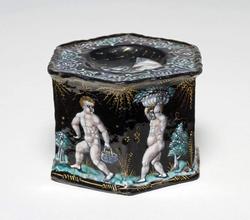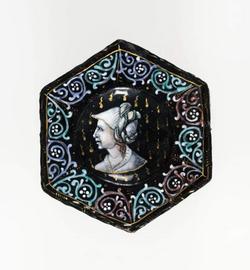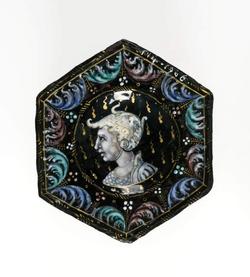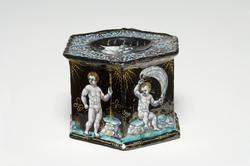Current Location: In storage
Titles
Hexagonal Salt
Maker(s)
Maker:
Reymond, Pierre
(Workshop of)
Entities
Categories
Description
Copper decorated with polychrome enamels and gilding with a female head on the top, a male head on the base, and on one side Cupid holding an arrow, and on each of the other sides a putto
Copper, enamelled in blue, pale bluish-green, flesh-pink, mulberry, and white on a black background, and gilded. Hexagonal with a circular depression in the top and bottom, projecting top and bottom edges, and straight sides.
In the salt pan there is a bust of a woman wearing a cap and elaborate coiffeur in profile to left, against a black background semé with gilt heraldic tears (gouttes), and surrounded by a border of three pairs of adorsed turquoise-green and mulberry foliated scrolls terminating in small white flowers, and three pairs of pale blue and turquoise-green. In the depression on the base is a bust of a man wearing armour and a parade helmet in profile to left surrounded by gold ‘tadpoles’ and enclosed by a gold line broken by groups of short oblique strokes. The border comprises small flowers on gold stalks flanked by pairs of feathery leaves: turquoise-green paired with blue; mulberry paired with turquoise-green; and blue paired with mulberry, repeated on the next three facets. The six sides are decorated respectively with Cupid standing beside a rock holding a gold arrow in his right hand, and a gold knot on a string in his left; a putto standing beside a small tree and holding aloft a bowl of fruit , a putto walking to the left holding a basket with a gold knot above his head; a putto sitting on the ground with a gold thread around his left leg and knot above, and overhead, a dove holding a gold necklace in its beak; a putto kneeling on a block of stone and beating a small drum; and a putto seated on a rock holding up a billowing drape. All have gold hair. At the top of each angle there is a half sunburst in gold. At the top and bottom there is a narrow gold line broken by five or six short oblique strokes.
Notes
History note: Cyril Humphris Ltd., London, from whom purchased by the Friends of the Fitzwilliam
Legal notes
Given by the Friends of the Fitzwilliam Museum
Measurements and weight
Height: 5 cm
Width: 7.5 cm
Acquisition and important dates
Method of acquisition: Given
(1966-06-16)
by
The Friends of the Fitzwilliam Museum
Dating
16th Century, Mid
Circa
1540
CE
-
1550
CE
Note
Hexagonal salts were fashionable during the mid 16th century and were made in silver, and ceramics, as well as in Limoges painted enamel. Limoges salts of this form bear dates from 1542 to 1547. The salt depression in the top and the matching depression in the base were usually decorated with a male or female head in antique or contemporary costume, sometimes identified in gold capitals as Paris and Helen, Hercules and Deianeira or Omphale, or Pallas and Jupiter. The sides were decorated with several different themes.The most popular, judging by the number of surviving examples, was the Twelve Labours of Hercules divided between two salts, which suggests that they were supplied in pairs. Others included half-length classical and contemporary male and female figures, classical and biblical male and female busts, singly or in pairs, sometimes enclosed by wreaths, and 'The Follies of Wise Men' and 'The Ages of Love' (see M. 50-1904), which diners probably found amusing. A few are decorated with nude little boys (putti) participating in the grape harvest, dancing, fighting, playing with various objects or on musical instruments. Pairs of analogous hexagonal salts with different heads in the salt depressions are in the Metropolitan Museum of Art, New York ( 32.100.372 and 32.100.373), and the Musée des Beaux-Arts, Limoges (84.432 and 84.433).
Putti in various roles, derived from Roman architectural ornament and reliefs on the sides of sarcophagi, had become increasingly popular as decorative motifs in Italy during the fifteenth century. These archetypes were dissemininated to France and elsewhere in Europe through prints by artists such as Nicoletta da Modena, Master IB, and Marcantonio Raimondi. They also appeared on the title pages and borders of late fifteenth-century illuminated manuscripts (e.g. the Fitzwilliam's Book of Hours MS 153) and printed books imported from Italy, and by the beginning of the sixteenth, were appearing in French examples. Putti in the role of cherubs occur on early sixteenth century Limoges enamels of religious subjects, but were not often depicted until the 1530s when classical subjects based on Italian prints were introduced. On this salt the boy holding up a basket of grapes and the boy sitting on the ground with a bird above him were probably copied from a print of 'Children Harvesting Grapes', dated 1529 by the Monogrammist IB after Raphael (Bartsch, VIII.311.35; Illustrated Bartsch, 16, p. 78, no. 35 (311) .
School or Style
Renaissance
People, subjects and objects depicted
Components of the work
Decoration
composed of
enamel
( blue, turquoise-green, flesh-pink, mulberry, black, and white)
gold
Materials used in production
Copper
References and bibliographic entries
Related exhibitions
Identification numbers
Accession number: M.4-1966
Primary reference Number: 139841
Stable URI
Audit data
Created: Saturday 6 August 2011
Updated: Friday 1 August 2025
Last processed: Thursday 14 August 2025
Associated departments & institutions
Owner or interested party:
The Fitzwilliam Museum
Associated department:
Applied Arts
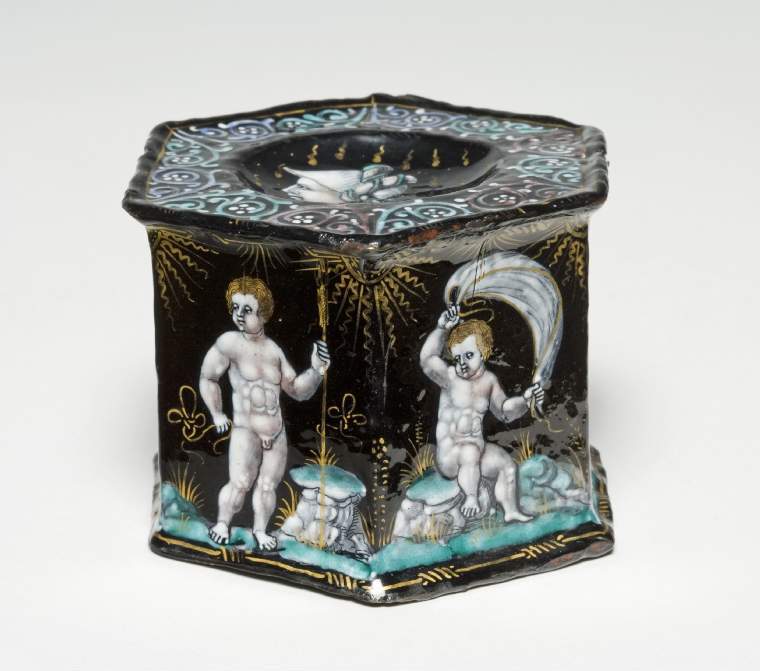
 IIIF Manifest
IIIF Manifest
